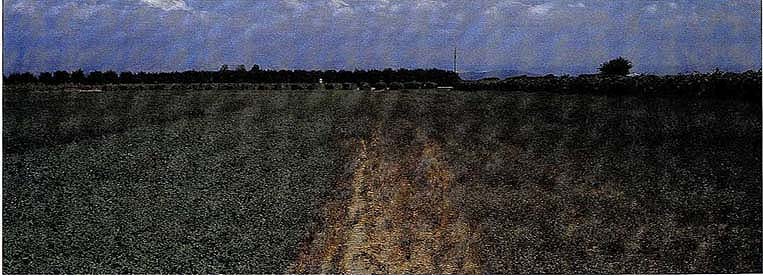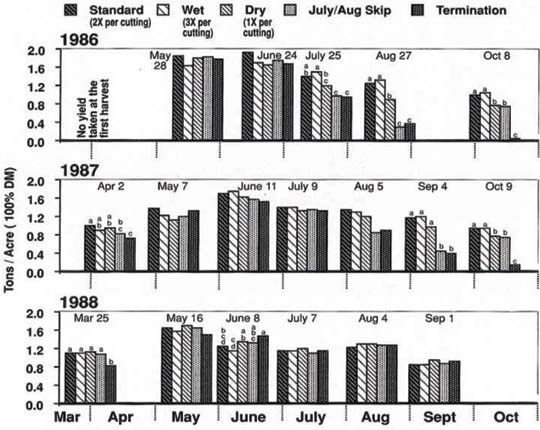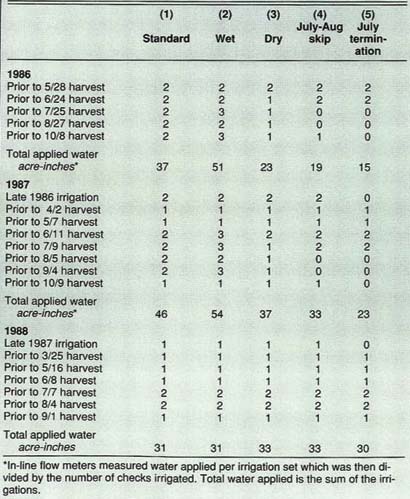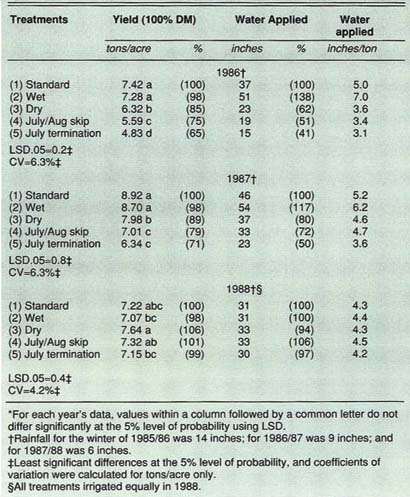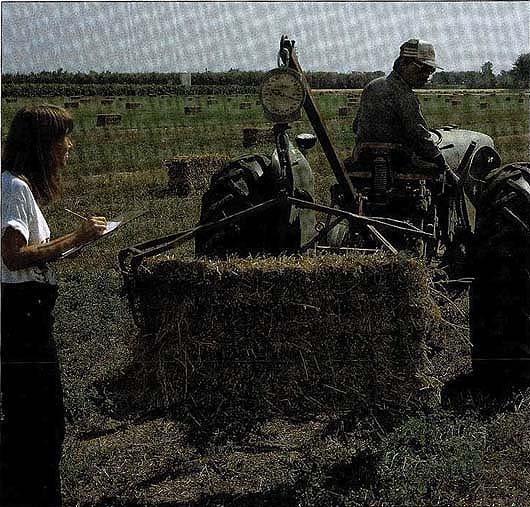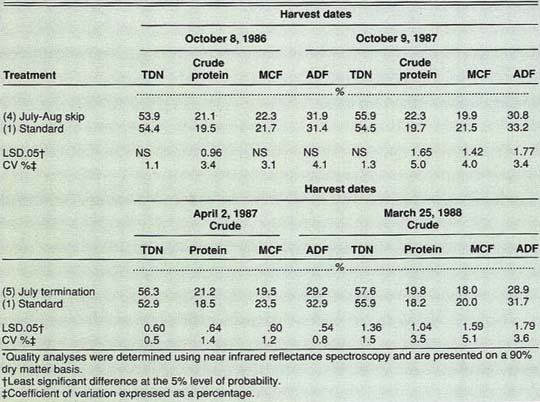All Issues
Imposed drought stress has no long-term effect on established alfalfa
Publication Information
California Agriculture 45(3):33-36.
Published May 01, 1991
PDF | Citation | Permissions
Abstract
Reducing or terminating irrigation on established alfalfa during summer months for two consecutive years reduced crop yields but had no long-term effects on the productive capability of the stand in the third year. Hay quality was negatively affected only when alfalfa was severely water-stressed.
Full text
September 1987 photograph of alfalfa irrigation trials at Kearney Agricultural Center. Check at upper left was irrigated throughout the summer; check at lower left was not irrigated in July and August, but watering resumed in early September; check on the right had not been irrigated since June.
In the South San Joaquin Valley, water can be the largest single cost of alfalfa production. Farmers apply 40 to 60 acre-inches in a normal year to obtain optimum yields. When precipitation falls below normal and irrigation districts cut back water deliveries, growers must manage with limited supplies. Water restrictions are likely to continue. Even in normal rainfall years ground water use by farms and cities exceeds annual recharge capacity in the South San Joaquin. Continued ground water depletion poses serious implications for both farms and cities which rely heavily on this water supply. We evaluated several options for farming with limited irrigation water, and assessed their long-term impact on alfalfa production and quality.
Methods
The alfalfa variety CUF 101, termed “very nondormant” for its tendency to grow in fall and winter, was planted in October, 1985 at the Kearney Agricultural Center in Fresno County. The soil type was a Hanford sandy loam with scattered hardpan. Plots 24 x 860 feet were flood-irrigated. The experimental design was a randomized complete block with four replications. Five irrigation treatments were imposed during the first two production seasons (1986, 1987). In the third year of production (1988), all treatments were irrigated identically in order to evaluate recovery from the previous 2 years.
Winter precipitation varied over the course of this experiment: 14 inches of rain fell during the winter of establishment, 1985-86; 9 inches fell during 1986-87, and only 6 inches fell during the winter of 1987-88.
The standard treatment (1) consisted of two irrigations per cutting from May to September. Other treatments varied from the standard as follows: The wet treatment (2) was irrigated three times per cutting from June through August (with the exception of August 1986 and July 1987 when only two irrigations were applied); the dry treatment (3) received two irrigations per cutting through May and then only a single irrigation per cutting from June through September; the July-August skip (4) was not irrigated in July and August but did receive a fall irrigation; and the July termination (5) received no irrigation after June until the following spring.
In the third year all plots were irrigated using the standard practice in the San Joaquin Valley of two irrigations per cutting. At times, exact treatment schedules could not be followed due to physical limitations of the irrigation system such as pipe availability and seasonal variability. Exact numbers of irrigations relative to harvest dates are shown in table 1. Total irrigation amounts were measured using an in-line flow meter. Applications to individual plots were estimated based on uniform set times. Commercial equipment was used to cut, rake, bale, and remove alfalfa. Plots were marked with straw to identify treatment boundaries. Straw markers identified partial bales from adjoining plots. Plot yields were measured by weighing random bales to determine average bale weight and then counting bales from each plot. Core samples from random bales were taken for determination of moisture, crude protein, modified crude fiber (MCF), and acid detergent fiber (ADF) to predict total digestible nutrients (TDN). Quality analyses were performed by Dairymen's Creamery Cooperative Association, Tulare, using near infrared reflectance (NIR) spectroscopy.
Results and conclusions
Treatment yields by cutting for each year are shown in figure 1. Irrigating three times per cutting in June, July, and August had no effect on yields compared to the standard treatment of two irrigations per cutting in 1986 and 1987. Irrigating once per cutting (dry treatment) reduced yields by 21% during the high water use months of July and August in 1986. In 1987 the dry treatment produced less than the standard and wet treatments in July and August, but these differences were not significant. By the last cutting in early October, the dry treatment produced 19% less than treatments watered two or more times per cutting during the summer.
Yields were reduced in July and August for the skip treatment and from July through the rest of the season in the termination treatment. The mid-season termination of irrigation also affected the recovery and yield of alfalfa in the cutting immediately following rewatering. However, by the second cutting after irrigation was resumed, skip and termination treatments produced yields equivalent to the wet treatment. The July-August skip treatment yielded as well as the dry (single) treatment at the final fall cutting and achieved full production by the first cutting of the following year. For the termination treatment, yields were reduced at the first cutting of the next year, but second cutting yields were equal to other treatments.
In 1988 when treatments were irrigated uniformly, yields at each cutting were similar for all treatments except for the first cutting. The first harvest of the termination treatment did not yield as much as other treatments.
Fig. 1. Yields by cutting for each year of alfalfa irrigation study, 1986-1988. For each cutting date, columns with the same letter represent values that do not differ significantly at the 5% level of probability using LSD. Where no letters are present, treatments did not differ significantly.
TABLE 1. Number of irrigations per treatment in alfalfa irrigation study planted October 1935 at Kearney Agricultural Center Parlier, California, 1986-1988
TABLE 2. Total annual yield (100% DM), applied water, and applied water per ton for 3 years of alfalfa irrigation study, Kearney Agricultural Center, Parlier, California*
Seasonal totals are shown in table 2. There were no significant differences between standard and wet treatments in the 3 years of the trial. For other treatments, yields decreased as applied water decreased. The dry treatment in 1986 produced 85% of the yield with only 62% of the applied water compared to the standard. In 1987, this treatment produced 89% of the standard treatment yield with 80% of the water applied. The apparently more efficient water use in 1986 compared to 1987 could be attributed to more residual soil moisture in 1986 following a winter with 14 inches of precipitation compared to only 9 inches in the winter of 1986-87.
Field assistant Garnett Cooke and agricultural technician Francisco Correa weigh bales at Kearney Agricultural Center.
TABLE 3. Quality analyses of hay samples from the first harvest following re-watering of Irrigation skip and termination treatments, alfalfa Irrigation trial, Kearney Agricultural Center, Parlier, California*
In 1988, when all treatments were irrigated uniformly, final season yields were not significantly different from the standard. However, the dry treatment produced significantly more total hay than the wet and July termination treatments. This may have been due to a healthier root system compared to the wet treatment and a more extensive root system compared to the July termination treatment.
The amount of water applied to produce a ton of alfalfa hay was lower for the dry, skip, and termination treatments than for the standard and wet treatments in the first two years of the trial (table 2). Whether this reduction in applied water at the expense of yield is profitable depends on hay prices and cost of water. The wet treatment demonstrated that under a non-saline situation there is no benefit to overwatering alfalfa. Although more water was applied in the wet treatment than in the standard, yields were the same, indicating that either additional water was not needed or that it was lost through deep percolation below the root zone.
There were differences between 1986 and 1987 in applied water per ton of dry matter produced for the dry, skip, and termination treatments. This could be due to the larger amount of rainfall in the winter preceding the 1986 production year compared to winter precipitation prior to the 1987 season. More water reserves in the soil resulted in increased growth when applied water fell short of crop needs.
Stress resulting from reduced irrigation did not have long-term effects on the ability of the crop to use applied water as shown by the 1988 data in table 2. When normal irrigation was resumed, all treatments used approximately the same amount of applied water to produce the same forage Yield. It is important to remember that this trial was intended to evaluate impact on yield due to less than optimum irrigation strategies. The purpose and design of the experiment was not to study water-use efficiency. The large-scale design, method used for measuring applied water, and harvesting techniques were not to the level of detail needed for crop water use studies. Such studies would include direct measurements of soil water depletion, exact and total control of all water applied to plots (large-scale plots and soil variability in this trial made such control very difficult), and harvesting methods that precluded any loss of yield due to raking and baling. Rather, this trial was designed to look at large-scale effects of very different management strategies that could easily be adapted at the farm production level. For this purpose, applied water was measured within the limits of available resources to estimate approximate amounts used by each strategy.
Water management affected yield much more than quality under the conditions of this trial. In general, hay quality was not significantly affected by irrigation treatments except when water stress became severe and then quality declined. The commercial practices of raking and baling used for this study would have masked minor differences in quality due to water stress. However, better hay quality was detected for skip and termination treatments in the first harvest following reirrigation (table 3). For example, crude protein analyses of the July-August skip treatment were 21.1% and 22.3% compared to 19.5% and 19.7% for the standard treatment in the October harvests of 1986 and 1987, respectively. The increase in quality at these cuttings was due to observed maturity differences. Once drought-induced plots were rewatered, initiation of plant growth was delayed compared to the standard, resulting in less mature, higher quality alfalfa at the time of cutting.
Results from this trial indicate that alfalfa planted in early fall can survive induced first and second year midsummer drought from irrigation cutoff and subsequently return to normal production within two cuttings after rewatering. Following two years of imposed summer drought, stressed treatments produced yields equivalent to the standard treatment in the third year of production during which all treatments were irrigated normally.
Results from this study could also be useful in helping growers make management decisions on how to utilize limited water resources. Yield responses to different management strategies, water costs, and alfalfa hay prices must all be considered in order to determine which method is most profitable.



